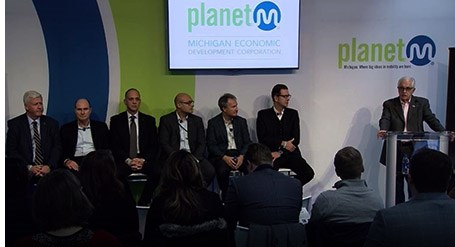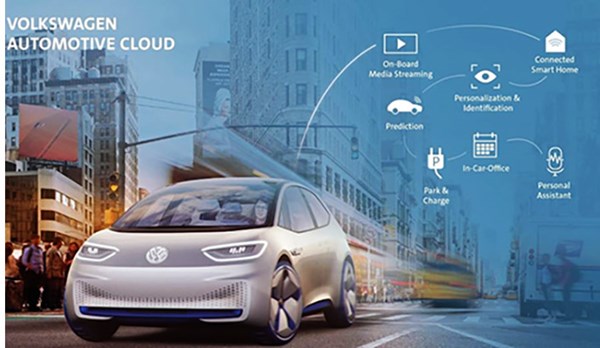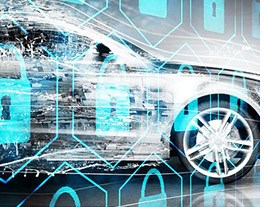Connected Vehicles Move to the Forefront of Advanced Mobility
While the hype about fully autonomous cars has slowed over the last year, the shift to connected vehicles is accelerating.
While the hype about fully autonomous cars has slowed over the last year, the shift to connected vehicles is accelerating.
Panelists at the recent “Connecting the Dots” symposium point to a host of potential benefits for so-called vehicle-to-everything (V2X) systems. These include improved safety, reduced traffic congestion, greater convenience and access to myriad services and technologies.

V2X allows vehicles to share information with each other, the infrastructure and third-party services, notes Patrick Hupperich, CEO of FEV North America. Speaking at the event, which was hosted by AutoBeat Daily and the Advanced Mobility Project in conjunction with the Automobili-D conference in Detroit, Hupperich says connectivity also is a key enabler for other emerging technologies, such as autonomy and car/ride-sharing services.
“Connectivity is really starting to take hold with some interesting opportunities,” adds Kevin Kerrigan, senior vice president-automotive for the Michigan Economic Development Corp. For example, integrated parking apps can help drivers quickly find and reserve available spaces to reduce congestion in crowded downtown areas.
Other early applications could include over-the-air (OTA) software updates, fleet management and linking diagnostic systems to schedule maintenance. Fleets could eventually use V2X to provide drivers with information about upcoming intersections or even remotely control geofenced automated vehicles in situations that are too complex for their sensors and control algorithms.

Connectivity will complement and build on the sensors outfitted on today’s cars, says Brian Murray, director of safety and security for ZF. Carmakers also are starting to use OTA technology to make software updates during the vehicle development phase.
But companies must find ways to monetize connected car systems as they are being developed, stresses Joerg Weisgerber (left), who heads Hella’s electronics operations in the Americas.
At the same time, he says the auto industry is trying to defend connectivity intrusions from cellular providers and other tech companies over who controls and cashes in on new services.
This may require taking a leap of faith, similar to Tesla’s approach on electric vehicles, OTA and the carmaker’s semi-autonomous Autopilot system. But traditional automotive companies tend to be more risk adverse, Weisgerber notes.
Cellular or DSRC?
Still up in the air is whether future connected cars will operate over fifth-generation (5G) cellular services or 5.9 GHz dedicated short-range communication (DSRC) systems. The latter is a broadcast band that was set aside specifically for automotive applications several years ago.
Emerging 5G systems promise to have significantly faster operating speeds and improved latency. They also will be able to use a car’s cellular modem and existing cell towers, which would be significantly cheaper than creating a DSRC infrastructure.

There may be room for both technologies, at least initially. FEV’s Hupperich points out that several carmakers already are using DSRC. GM launched the technology in 2017 on its Cadillac CTS sedan, allowing similar equipped vehicles to share information when they are in close range. Mercedes, Toyota and Volkswagen also are using DSRC in select vehicles. Such applications can help generate excitement for V2X prior to launching 5G, Hupperich says.
DSRC also can provide an advantage in areas with limited or no cellular coverage. MEDC’s Kerrigan says Michigan already has DSRC installations on more than 350 miles of road.
With 5G automotive chipsets likely two or more years out, Ghosh says the industry should make the most of current 4G systems, which could remain in use for another decade. “Before we invest in the next technology, we need to pay off the last one.”
There also could be unforeseen challenges in implementing 5G. For example, Borroni-Bird cautions that widespread adoption will require a dense network of cell towers that could have potential health ramifications.
Securing the Future
Other concerns include cybersecurity and customer privacy. Companies have beefed up their efforts—working on their own and as a group—to thwart hackers. But the panelist note that no system is foolproof.

The industry must take a layered approach to cybersecurity, ZF’s Murray asserts. This includes designing systems from the ground up to prevent breaches, properly authenticating communications are from approved sources and continually checking to see if a system has been hacked. In addition, he says, companies must work together and share information about vulnerabilities and threats.
Just as important, Ghosh says, is having various contingency plans on how to respond to intrusions when they happen. As connectivity features are added across platforms, the situation is amplified because attacks have the potential to affect millions of vehicles simultaneously.
“Cybersecurity will become a part of the overall vehicle development cost,” Kerrigan adds.
It’s unclear how much privacy consumers want. People already provide a lot of personal information via social media, their smartphone carriers and various apps. But new restrictions are being developed, such as Europe’s General Data Protection regulation, that will require greater transparency on what data companies are capturing and how they are using it.
Watch the full conference HERE.
RELATED CONTENT
-
Things to Know About Cam Grinding
By James Gaffney, Product Engineer, Precision Grinding and Patrick D. Redington, Manager, Precision Grinding Business Unit, Norton Company (Worcester, MA)
-
Multiple Choices for Light, High-Performance Chassis
How carbon fiber is utilized is as different as the vehicles on which it is used. From full carbon tubs to partial panels to welded steel tube sandwich structures, the only limitation is imagination.
-
On Electric Pickups, Flying Taxis, and Auto Industry Transformation
Ford goes for vertical integration, DENSO and Honeywell take to the skies, how suppliers feel about their customers, how vehicle customers feel about shopping, and insights from a software exec








